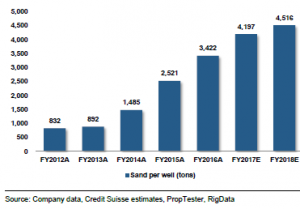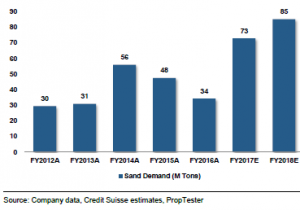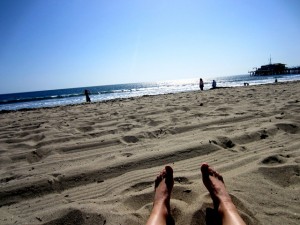Toes in the Sand
For me, and I think I speak for everyone on the planet, the feeling of warm sand between the toes is one of life’s great pleasures. And for virtually everyone on the planet, including those of us who look at a beach every day (ok, I may be rubbing it in), we don’t give sand much thought: it’s just there.
But sand is more than pretty beaches; it’s big business. And it’s gotten to be even bigger business with the advent of the Shale Revolution. That’s because a lot of subsurface rocks that contain oil and gas lack permeability, which prevent fluids from flowing through them. To solve this problem, engineers drill a hole into the rock and shoot under high pressure a mixture of treated water, thickened with guar gum usually, and sand. The rocks fracture, and billions of grains of sand remain lodged in the newly created pores, propping them open.
Lest you think sand is sand, not just any sand will do the trick. Only high purity quartz sand will do, very durable to resist crushing, perfectly round so it will travel easily, and of a very specific size, normally 0.4 and 0.8 millimeters in diameter. The photo below shows “normal” sand on the left, frac sand on the right. See how much more uniform (and shiny) the frac sand is?

And drillers need a lot of it, especially as the porous rock has been tapped previously. A few years ago, 1,000 tons of sand were needed for each well; today, more than 4,000 tons of sand are required per well (see graph below). Overall, demand for sand will more than double this year from last, to over 70 million tons (see second graph below).
Sand Intensity

Sand Demand

So where does all this sand come from? Well, while Texas may have blessed with oil and gas, Wisconsin was endowed with high quality sand (who knew?). But mining sand in Wisconsin and shipping it to the oil fields is expensive, about $50/ton, more than half the total cost of sand (see map below).

You can’t just dig up sand and sell it; to mine sand requires a permit, even in Texas. And this year, permits have been filed in Texas to mine about 34 million tons of sand; permits for another 11 million tons are in the works. Sand costs in the Permian Basin run about $90/ton. This Texas sand will cut that cost more than in half. That’s really bad news for the companies that own and ship sand from Wisconsin, which is why their stock prices are off 50% this year; good news for the Texas drillers.
Of course, all this is more complicated than it seems, and the hopeful sand miners in Texas face some obstacles. Money is one; One company plans to spend $225 million on a 4 million-ton capacity plant, plus will have to pay $1/ton in royalties. Another company just paid a rancher $323 million to build a 3 million-ton capacity plant on his land.
There’s also very little infrastructure in west Texas to transport all this sand. Much of the new sand is near the town of Kermit (named after Theodore Roosevelt’s son, and famous as the birthplace of the great bull rider, Jim Sharp). Kermit is big enough to have traffic lights (population: 6,300), and estimates are that at full capacity, a sand truck pass through town every 19 seconds. Folks in West Texas are very supportive of the oil and gas industry, but that’s a lot of trucks rumbling through town.

Then there’s the matter of the dune sagebrush lizards. These critters reside in a very small habitat, that with Shinnery oak. The US Fish and Wildlife Service proposed adding the dune sagebrush lizard to the endangered species list in 2011, but withdrew that recommendation the following year when Texas promised to preserve its habitat.

Every day I look at the beach (there I go again, rubbing it in), and never gave sand much thought. But now I know that my Santa Monica sand is too soft and irregular for use in fracking, but just right for sinking toes into.


